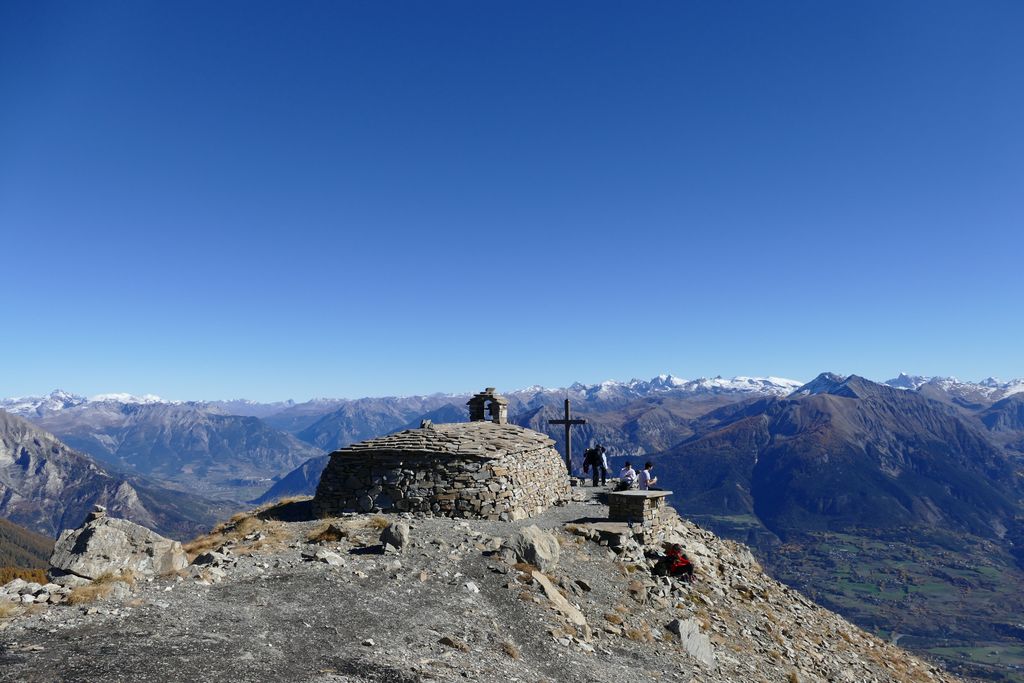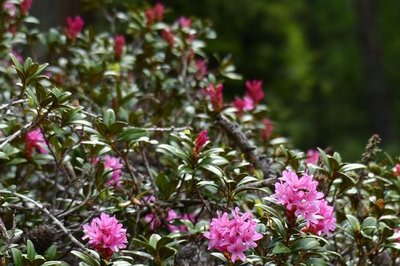
The Mont Guillaume
Overhanging the town of Embrun which is less than 5 km away, the Mont Guillaume is particularly important for its inhabitants. Seyères chapel has been completely restored, and at the beginning of July it welcomes a mass dedicated to Saint Guillaume which lends an extra dimension to this hike.
Description
At the carpark, take the forest road for 50 metres and skew to the right on the Widman track. Join the path. On the first bend to the right, ignore the path on the left and go up the track (Séyères chapel, mont Guillaume by Pré-Clos). Leave the path at the fourth bend to take the track to the left (Séyères chapel, mont Guillaume on the Widman track). Ignore the first path that goes down to the right, then another facing that climb up to the crossing. Take the path on the left until Séyères chapel 200 m away (fountain, picnic area). Continue along the same path and take the track to the right (Mont Guillaume on the Widman track) at the fork. At the first bend (cairn), climb the track to the Saint Guillaume chapel (2542 m), then to Mont Guillaume. Return using the same itinerary.
- Departure : Hameau de Caleyère, Embrun
- Towns crossed : Embrun
14 points of interest

Mélézin - Mireille Coulon - PNE  Flora
FloraThe larch
The king of mountain trees in the Southern Alps, the larch is the only conifer to drop its needles in winter. In spring, its cones are a characteristic dark purple. The larch is one of the few European tree species that is imputrescible, that is to say, it does not rot. This is why, despite the fact that it twists as it dries out, it is widely use in frameworks, drinking troughs and other water holding vessels in the mountain villages. Incapable of germinating in its own undergrowth, it needs natural openings such as avalanche corridors for the young shoots to develop. It is found at altitudes in excess of 2,200 metres, adopting dwarf forms in these "combat" zones. The larch tree growing at this point on the trail is several hundred years old.
 History
HistoryThe Widman track
On the 12th February 1897, wanting to show that skiing was faster across the snow than crossing it with the snow shoes then provided to the mountain troops, Charles Eric Widman, lieutenant in the 28th Alpine battalion at Embrun, undertook the ascent of Mont Guillaume. He left at 5 o’clock from the station and reached the summit at 10h30, after having climbed an elevation of 1681m. He carried out the first ascent on skis in the French Alps. On the one hundredth anniversary of this exploit, this itinerary was named the « Widman Track».

Orchis globuleux - Bernard Nicollet - PNE  Flora
FloraGlobe Orchid
In the orchid family, the Globe Orchid needs a lot of light to develop and can often be seen in the meadows. Its leaves are all on the stalk which ends in a globular inflorescence with many small flowers. These form a dense spherical spike. They possess a short spur, external sepals which are well spaced, and a speckled tri-lobed labellum.

Orties - Amélie Vallier  Flora
Floracommon nettle
Called the common nettle, this is a stinging plant. During difficult times in history – the Middle Ages or the world wars for instance, it was consumed to help survive periods of famine and scarcity. Rich in protein, vitamins and minerals, it is highly effective health cure and is taken as a soup, and added ingredient to various other dishes or as a soft drink. Apart from this usage, in the sixteenth century it was put to industrial use, in the manufacture of paper, garments etc.
Pastel des teintutiers - fruits - Bernard Nicollet - PNE  Flora
FloraDyer’s Woad
Punctuating the edges of the paths, this green and blue-green biennial, is also known as « Saint Philippe’s herb ». A large robust plant topped with a parasol of yellow flowers, it has many uses. While its leaves provide a blue dye used to colour clothes, façades and carts (the famous « blue cart » which had the virtue of repelling flies), its roots are used against the mumps, infectious hepatitis, sore throat or the fever.

Pied de coq - Amélie Vallier  Flora
FloraMeadow buttercup
More commonly called the buttercup, this is a very familiar flower. It flowers from May to September, and commonly grows in grasslands and the edges of tracks. Its stems and leaves are slightly hairy. It is seldom eaten by livestock because it is toxic, and it only loses its toxicity when dried. This plant is a member of the large family Ranunculaceae.
Chevreuil - Damien Combrisson - PNE  Fauna
FaunaRoe Deer
Hidden in the larch forest, the Roe Deer sometimes shows its fine head at dawn or at dusk. Not always easy to see this discreet animal but a few tracks or droppings can give its presence away.: the heart shaped print of its delicate hooves, the trunks of shrubs nicked by young fallow deer rubbing new antlers there to remove the last shreds of velvet, the ground scratched by the young male to mark his territory during the rutting season. Sometimes it is a deep sonorous and guttural bark that resonates in the woods.

Genévrier commun - Jean-Pierre Nicollet - PNE  Flora
FloraCommon juniper
This shrub is an evergreen and resinous conifer. It is known for its green to blue (glaucous) needles with a white line across the top and berry-like, blue-black fruit. It generally thrives in warm, sunny areas. It grows in grassland and scrubland at altitudes of up to around 2,000 m.
.
Orchis pâle - Nicolas Marie-Geneviève  Flora
FloraPale Orchid
A perennial plant 10 to 30 cm high, the pale orchid likes the edge of forests and the alpine meadows (400 to 2400 m), and slightly acidic chalky terrain. It is easily recognizable thanks to its pale yellow flowers which extend in to a long upstanding spur. This robust plant, with large green oblong shaped leaves, has an elderberry scent.

La chapelle des Séyères - Elisabeth Tholozan - PNE  History
HistorySéyères Chapel
Rebuilt in 1859 by Monseigneur Depery, Bishop of Gap, the Séyères chapel is dedicated to Saint Guillaume. Near to Calme priory (under Mont Dauphin Fort), in the 12th century, little Guillaume was born without a right hand. While he was looking after the flocks belonging to the monastery, he received several visits from an angel announcing that the priory would be destroyed by a flood. With each alert, Guillaume, warned the monks but in vain. The angel gave him his missing hand in order that his message should be understood. If the convent was evacuated before the expected flood only a small chapel attached to the Western slope of the Mont Dauphin rock remains.

Rhododendron ferrugineux - Ludovic Imberdis - PNE  Flora
FloraRhododendron ferrugineux
Also called the Rose of the Alps, this medium sized shrub likes the rocks, the grassland and light woodland. Its hairless smooth edged leaves are dark green and shiny underneath. A bright pink colour its fragrant flowers are grouped by 6 to 10 at the end of the branch. Be careful not to ingest its fruits, oblong 4 to 7 mm long capsules: they provoke vomiting, diverse digestive, nervous, respiratory and cardiovascular problems.

Perdrix bartavelles - Damien Combrisson - PNE  Fauna
FaunaRock Partridge
Here is another gallinaceous bird, like the Rock Ptarmigan, most easily observable at mating time in Spring. Perched on the promontory to sing in its jerky fashion, the Rock Partridge is recognizable by its grey back, its striped sides, its white throat and its red beak. It lives in the mountains on slopes that are well exposed to the sun and prefers rocks and moors where the young can feed on insects which are necessary for their growth.

La chapelle du Mont Guillaume - Christian Couloumy - PNE  History
HistoryMont Guillaume Fraternity of Priors
70 members strong, this fraternity of lay men « which undertakes the maintenance of the chapels, oratories and crosses, to carry out works of solidarity, and to continue to bring to life the priory and its traditions » has existed since the 13th century. Even if each Prior is a Prior for life, every year the fraternity receives the support of two new members, chosen three years before: one living on the sunny side of the mountain (which is on the side of the town here), the other on the shadier side (the slope towards the countryside). There is no social distinction at the heart of the Priors. Lawyer, carpenter, barman, it is the same for everybody and they all share the same values.

Vue depuis le Mont Guillaume - Elisabeth Tholozan - PNE  Panorama
PanoramaAn overview of the Embrunais
The summit of Mont Guillaume offers a magnificent overview of the numerous summits in the Embrunais: the Pic de Morgon (2324 m), the Aiguilles de Chabrières (2403 m), the Mourre Froid (2993 m), the Tête de l'Hivernet (2824 m), the Mont Orel (2563 m), etc... At your feet you can contemplate the Durance valley, and the lakes at Embrun and at Serre-Ponçon.
Forecast
Altimetric profile
Information desks
Tourist office Embrun
Place Général Dosse - BP 49, 05202 Embrun
October to march : Monday to Saturday, 9.00 - 12.30 & 13.30 - 17.00.
April, may, june & september : Monday to Saturday, 9.00 - 12.30 & 14.30 - 18.00
July and August : Monday to Saturday, 9.00 - 19.00. Sundays, 10.00 - 12.30 & 16.00 - 19.00
On French national holidays (except 14th of July and 15th of August) : 9am to 1pm. Closed on the 1st of January, 1st of May, 25th December and 11th November
Closed on Thursdays outside French holidays’ periods
Maison du Parc de l'Embrunais
Place de l’Église, 05380 Châteauroux-les-Alpes
Information, documentation, exhibition, screenings, products and books of the Park. Accessible to people with reduced mobility. Free admission. All animations of the Park are free unless otherwise stated.
Transport
Bus line Marseille Gap - Briançon ( www.info-ler.fr ) and SNCF station at Embrun.
Access and parking
From Embrun station, go up to the highest point of the town, cross the railway track then take the direction to Caleyère up to the hamlet. Next continue in the direction of the Forest gates.
Parking :
Source

Report a problem or an error
If you have found an error on this page or if you have noticed any problems during your hike, please report them to us here:


